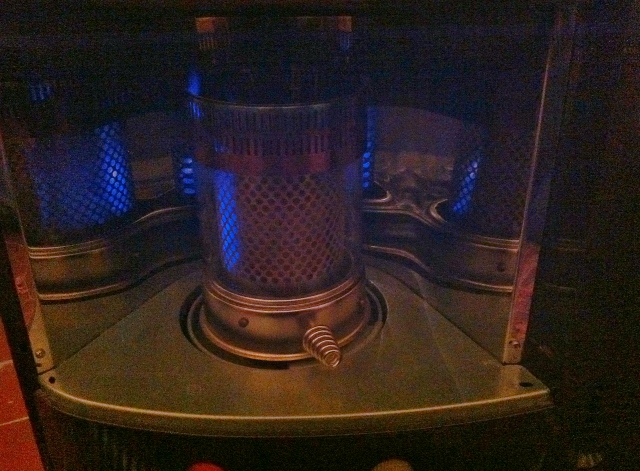Heating
(click on "Living" menu item to return to previous page)
The Wood-burning stove
| Living on a hilltop makes collection of proper firewood
challenging. Villagers who live here all winter order their firewood from a local supplier who brings it up to the house. For those of us who only stay here for several weeks, finding firewood can be entertaining. This type of firewood warms you up three times: when you collect it, when you chop it, and when you burn it. Although collecting firewood is a fun activity we often do not bother and buy the pressed woodbricks at the local supermarkets. These are called Tronchetti di Legno and often have a an ECO sign. They cost about 4 euro for 10 kilo and last two days. The advantage of these tronchetti over regular firewood is that they easily burn, have much higher heat output and leave no ashes. |
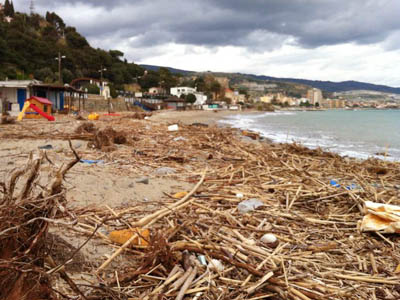 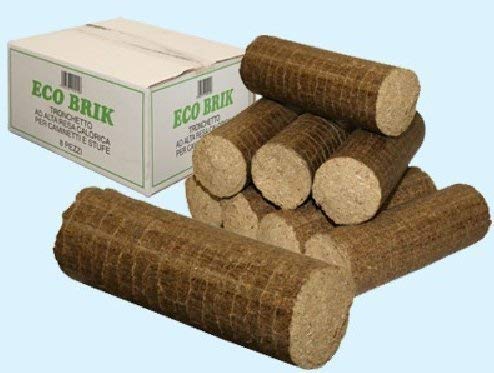
|
The Brabus stove has 80% efficiency and should, if properly maintained, generate up to 7 kW of power. During winter we only use the two bedrooms downstairs. The studio bedroom has no heating but can be heated if needed using the Zibro Wick odorless paraffin burner (which has 99% efficiency). |
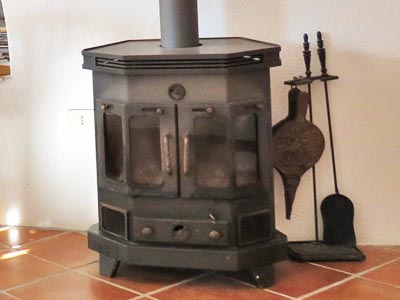 |
| You start by pulling the chimney lever to the right. This opens a shortcut from the fireplace into the chimney which allows the chimney to heat up quickly. The quicker the chimney is at temperature, the better the fire will burn with minimy risk of smoke in the room. You can close the lever (push to the left) when the iron chimney pipe is too hot to touch: typically when the fire has burnt for 10-15 minutes. |
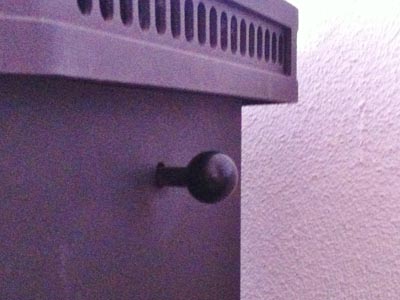 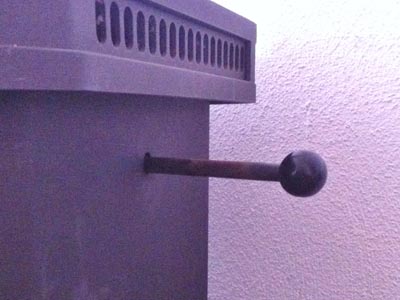 |
At the start of the fire, there needs to be ample oxygen from below to boost the fire. You can support this by completely opening the round airvent below by pulling thehandle above the ash drawer and by opening the ash drawer a little, as depicted here. Once the stove is hot (20-30 minutes) you can slowly close the ash drawer and push the lever of the fireplate grate in short intervals inwards to about 80% close. You maintain the fire by opening the round airvent when you add more firewood or close it to temper the fire so it will generate heat while burning less wood. |
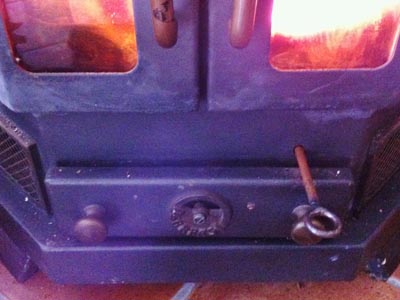 |
The round airvent above the doors is to mix the hot air from the fire with colder outside air before it passes into the chimney. This creates draught at the inside-front of the chimney that reduces smoke deposit on the windows. The copper knobs above the windows serve the same purpose: they reduce stains on the windows from the smoke (if moved to the left). The windows of the stove are treated to withstand the high temperatures. Before starting the fire in the stove you can clean them with an old newspaper that you dip into a little water and next in the ashtray. The ash is slightly abrasive which makes it easy to keep the windows clean. Please support a window with one hand on the outside of the stove while the inside is cleaned. Don't use any detergents because they are useless against smoke stains. |
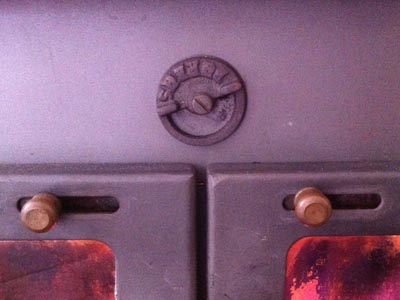 |
Light the fire by placing two white firestarter cubes on the fireplate. Build small kindle wood around this in the form of a rectangular stack so that it gets maximum heat from firestarters (and old newspaper if you have it). Place one or two eco-friendly burning logs on top. |
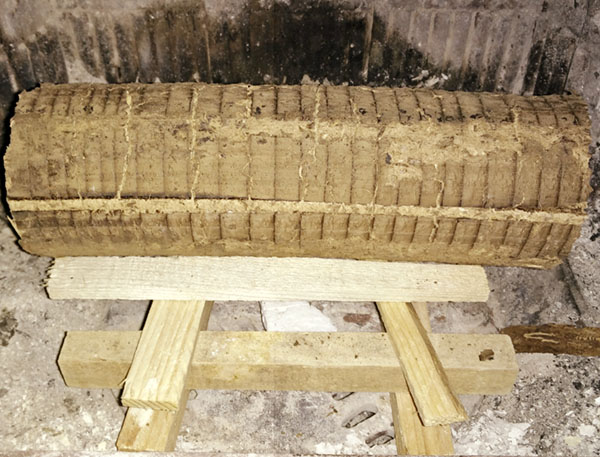 |
The Zibro Kamin Paraffin Heater
| This heater is stored in a brown cardboard box underneath the stairs to the terrace. It burns paraffin (kerosone) which is odorless. There usually is a 10-15l container in the house in winter. if not then they can be purchased in most supermarkets or in the Self DIY store behind the Taggia railway station (on right side of the Super Carrefour). The efficiency of the Zibro heaters is nearly 100% and they produce little exhaust gases. Nevertheless, for prolonged usage it is prudent to make sure there is some air ventilation in the room, e.g. by opening the small window in the living room a few centimeters (or 1"). This smaller Zibro heater has about 2 kW power. This is sufficient for heating on a chilly Spring or Autumn evening. During winter it will be needed to light the stove and use this heater to heat up a bedroom in the evening or the living room in the morning when the stove is warming up. |
.jpg) |
If the heater hasn't been used for a while it is stored with a yellow cap underneath the paraffin tank to avoid leakage. You need to remove this yellow cap otherwise the paraffin in the tank cannot reach the wick element. |
.jpg) .jpg) |
After placing the filled tank with paraffin in the heater you can light it. The version in the house has electric ignition, provided the batteries (in the back) are still operational. Given the very few times that the heater is needed there will be a big chance the batteries are empty. In that case you need to light the wick with a match. For this, you need to open the grate on the front side of the heater by pressing its right side towards the left. This will unhook the two small pins of the grate from the housing of the heater. |
.jpg) .jpg) |
After removing the grate, carefully lift the metal/glass burning tower from the heater. You can now access the wick. On the front of the heater you see a large brown turning knob and a red and a white button. The knob is to open the flow of paraffin from the tank to the combustion chamber, and to raise the wick to adjust the heat. To light the heater you need to rotate the big brown knob clockwise to its maximum. This enables the paraffin to enter the wick area. You can hear it making a bubbly sound when you turn the knob. |
.jpg) |
Take a long match to light the wick. Place the metal/glass combustion tower over the wick immediately after you have lighted it. Otherwise the fire will damage the wick. If it does not rotate freely either the heater is not placed horizontal or the combustion chamber is not properly placed over the wick. please adjust if needed. |
|
| The first few minutes the flame in the combustion chamber is pale blue, and sometimes difficult to see. After three or four minutes the outer, grated, walls of the combustion chamber will start to glow red and the heater is fully operational. The flames in the combustion chamber should be a little under the top edge of this chamber for maximum efficiency. If they are too high above, or too far below the edge you can adjust by rotating the brown know a little to the left to lower the wick or, alternatively, to the right to raise the wick and increase the flames. |
.jpg) .jpg) |
Any comments or suggestions: Let me know!
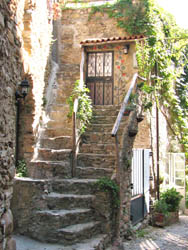
.jpg)
.jpg)
